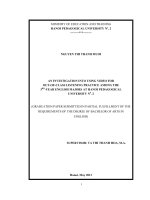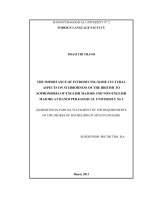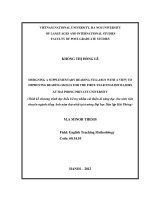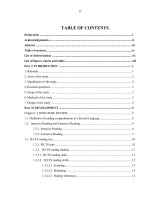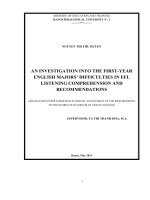The perception of first year english majors at hanoi pedagogical univerity 2 towards the effectiveness of shadowing technique as a method of improving speaking skills
Bạn đang xem bản rút gọn của tài liệu. Xem và tải ngay bản đầy đủ của tài liệu tại đây (948.29 KB, 59 trang )
HANOI PEDAGOGICAL UNIVERSITY 2
FACULTY OF FOREIGN LANGUAGES
NGUYEN THI TRA GIANG
THE PERCEPTION OF FIRST-YEAR ENGLISH MAJORS AT HANOI
PEDAGOGICAL UNIVERSITY 2 TOWARDS THE USE OF THE
SHADOWING TECHNIQUE TO IMPROVE SPEAKING SKILLS
SUPERVISOR: DO THI HUONG, M. A.
HANOI, 2019
HANOI PEDAGOGICAL UNIVERSITY 2
FACULTY OF FOREIGN LANGUAGES
NGUYEN THI TRA GIANG
THE PERCEPTION OF FIRST-YEAR ENGLISH MAJORS AT HANOI
PEDAGOGICAL UNIVERSITY 2 TOWARDS THE USE OF THE
SHADOWING TECHNIQUE TO IMPROVE SPEAKING SKILLS
SUPERVISOR
DO THI HUONG, M. A.
HANOI, 2019
DECLARATION
I certify that this minor thesis entitled “The perception of first-year English
majors at Hanoi Pedagogical Univerity 2 towards the effectiveness of
shadowing technique as a method of improving speaking skills” is the study of
my own research and the substance of this research has not been submitted for a
degree to any other university or institution.
Hanoi, 2019
Nguyen Thi Tra Giang
i
ACKNOWLEDGMENTS
I would like to express my gratitude to all those who have given me great
assistance in the completion of my research work.
In the first place, I would like to express my heartfelt gratitude to my
supervisors, M.A. Do Thi Huong, and M.A. Do Thi Thanh Dung, for their
continuous support with insightful discussion, helpful comments, and honest
criticisms. Without their guidance and help, this thesis would not have been
accomplished.
Secondly, I am greatly indebted to the Faculty of Foreign Language (FFL),
Hanoi Pedagogical University 2 (HPU2), for giving me the honor of writing this
research. I also sincerely thank all the lecturers and staffs of the faculty for their
valuable lessons and precious help.
Moreover, I am thankful to my family and friends from the bottom of my
heart. I could not go through the hardship to complete this study without their
support and encouragement.
Last but not least, my sincere thanks also go to all the participants for their
willingness and honest to join in this study, especially ten students in the focused
group for taking part in my project.
ii
ABSTRACT
The majority of language learners encounters difficulties when speaking in
the target language. For the first-year English majors at HPU2, there still have some
common problems regarding speaking practice, such as lack of vocabulary, poor
pronunciation, etc. So, it is essential that different speaking techniques should be
taken into consideration to enhance students‟ speaking skills. Meanwhile,
shadowing is a technique that has been widely used around the world, especially
Japan, to practice speaking and listening for many years. Many studies have shown
that shadowing helps to raise awareness of the target language sounds as well as
developing proficiency in speaking mainly in university students (e.g., Hamada,
2011a, 2012; Kato, 2009; Kuramoto & Matsuura, 2002). However, in the context of
Vietnam, it is still a new method that only a few colleges have applied it to train
students oral abilities. Especially in the Faculty of Foreign Languages (FFL) at
HPU2, majority of students have not known this method to practice speaking.
Therefore, it needs investigation. As a result, this study was set out to explore firstyear English majors‟ primary speaking problems, and their perspective of the use of
shadowing technique and their difficulties when applying it to practice speaking.
The research utilized questionnaires and interviews to collect data on selfevaluation of two groups, one group conducted of 50 students about their speaking
mistakes, and the target group consisted of 10 students, who came from the first
group, about the effectiveness of shadowing and the difficulties when applying it.
As can be seen from the qualitative and quantitative data, the results illustrate that
students‟ opinions about the use of shadowing technique in the improvements of
speaking abilities are positive. It proves that the use of the shadowing technique can
improve students‟ speaking abilities. Some solutions are also provided in this study
to help students have appropriate ways when using shadowing to enhance speaking
skills.
Keywords: shadowing technique, shadowing, first-year English majors,
speaking problems.
iii
LIST OF ABBREVIATIONS
EFL: English as a Foreign Language
FFL: Faculty of Foreign Languages
HPU2: Hanoi Pedagogical University 2
p: page
iv
LIST OF TABLES AND FIGURES
LIST OF TABLES
Table 1. Categories to evaluate speaking abilities (Pineda, 2017, p15) .................. 5
Table 2. The procedure of the shadowing technique ............................................... 10
Table 3. Classification of shadowing (cited in Tamai, 2005) .................................. 11
Table 4. Murphey‟s types of shadowing (2001) (as cited in Hamada, 2012) .......... 11
Table 5. The level of negativity of factors causing difficulties when students
practice with shadowing technique .......................................................................... 27
Table 6. Students‟ level of frequency encountering shadowing difficulties ............ 31
Table 7. Students‟ self-evaluation of improvement after one-month practicing
shadowing................................................................................................................. 32
LIST OF FIGURES
Figure 4.1. Students‟ self-evaluation their speaking skills ...................................... 22
Figure 4.2. Students‟ common problems when communicating in English ............ 23
Figure 4.3. Students‟ awareness of the shadowing technique ................................. 25
Figure 4.4. Students‟ attitude towards the effect of the shadowing technique in
speaking .................................................................................................................... 26
Figure 4.5. How often students practice the shadowing technique .......................... 29
Figure 4.6. Students‟ willingness to continue practice with shadowing technique . 34
v
TABLE OF CONTENTS
DECLARATION ........................................................................................................ i
ACKNOWLEDGMENTS.......................................................................................... ii
ABSTRACT .............................................................................................................. iii
LIST OF ABBREVIATIONS ................................................................................... iv
LIST OF TABLES AND FIGURES ...........................................................................v
TABLE OF CONTENTS .......................................................................................... vi
CHAPTER 1: INTRODUCTION ...............................................................................1
1.1.Overview ...............................................................................................................1
1.2. Rationale of the study...........................................................................................1
1.3. Aims of the study .................................................................................................2
1.4. The research questions .........................................................................................2
1.5. Scope of the study ................................................................................................2
1.6. Organization of the study .....................................................................................3
CHAPTER 2: LITERATURE REVIEW ....................................................................4
2.1. Overview ..............................................................................................................4
2.2. Speaking skills .....................................................................................................4
2.2.1 Definition of speaking ........................................................................................4
2.2.2 Aspects of speaking skills ..................................................................................4
2.2.3 Common problems in learning speaking skills ..................................................6
2.3 Shadowing technique ............................................................................................7
2.3.1 Definition of shadowing technique ....................................................................7
2.3.2 Stages of shadowing task ...................................................................................8
2.3.3 Classification of shadowing .............................................................................10
2.3.4 The importance of shadowing technique in developing speaking skills..........12
CHAPTER 3: METHODOLOGY ............................................................................14
3.1 Overview .............................................................................................................14
3.2 Participants ..........................................................................................................14
3.3. Instruments .........................................................................................................15
3.3.1. Questionnaire ..................................................................................................15
vi
3.3.1.1. The first questionnaire..................................................................................16
3.3.1.2. The second questionnaire .............................................................................16
3.3.2. Interview .........................................................................................................16
3.3.2.1. The first interview ........................................................................................17
3.3.2.2. The second interview ...................................................................................17
3.4. Procedure............................................................................................................18
3.4.1. Questionnaire procedure .................................................................................18
3.4.2. Interview procedure ........................................................................................18
3.4.3. Shadowing procedure ......................................................................................18
CHAPTER 4: FINDINGS AND DISCUSSION ......................................................21
4.1. Overview ............................................................................................................21
4.2. The speaking problems encountered by the first-year English majors of HPU2
...................................................................................................................................21
4.2.1. Students self-evaluation their speaking abilities .............................................22
4.2.2. Students‟ common problems when communicating in English ......................23
4.2.3. The awareness of students of the shadowing technique .................................25
4.2.4. Level of the frequency of students practice shadowing technique .................26
4.3. Students‟ perspectives in the effectiveness of the shadowing technique ...........27
4.3.1. Students‟ self-evaluation their improvement after one-month shadowing .....27
4.3.2. Students‟ attitudes towards the effects of shadowing technique in practicing
speaking .....................................................................................................................29
4.4. Some difficulties faced by students when practicing shadowing technique ......30
4.4.1. The level of negativity of factors causing difficulties when students practice
shadowing technique .................................................................................................31
4.4.2. Students‟ level of frequency encountering shadowing problems when
practicing shadowing ................................................................................................32
4.4.3 Students‟ willingness to continue practice with shadowing technique ............34
CHAPTER 5: CONCLUSIONS AND SUGGESTIONS .........................................36
5.1 Overview .............................................................................................................36
5.2. Conclusion..........................................................................................................36
5.3. Limitations of the study .....................................................................................37
vii
5.4. Suggestions for further study .............................................................................37
REFERENCES ..........................................................................................................38
APPENDICES...........................................................................................................42
APPENDIX 1 ............................................................................................................42
APPENDIX 2 ............................................................................................................45
APPENDIX 3 ............................................................................................................48
APPENDIX 4 ............................................................................................................49
viii
CHAPTER 1: INTRODUCTION
1.1.Overview
This chapter reviews some overview information about this study.
Particularly, the first part is about statements of the problems, why this research was
conducted. The second part provides the aims of the study. Then the next part gives
information about the scopes as well as some significance of the study. The last part
is the outline organization of this research paper.
1.2. The rationale of the study
In the world in general and Vietnam in particular, in the past few years, it can
not be denied that English is boosting, and much more attention has been paid to
educate English (Luu, 2014). Due to its significance, people have taken great
sufficient consideration into gaining the language in order to reach the international
level. Many institutes, centers, and university‟s departments have been in operation
because of English bloom to meet learners‟ needs of mastering four skills, including
speaking, the most difficult skill to master English (Zhang, 2000). Also, the firstyear English majors at Hanoi Pedagogical University 2 often fall into confusion
while speaking English because of the lack of practice, knowledge, and confidence.
However, another serious problem is the lack of self-study methods which are
suitable with their level. In order to improve their speaking skills, shadowing
technique is in top choices as its effectiveness has been proved in many countries,
especially Japan.
Recently, the shadowing technique is attracting much attention of English
educators and learners. Originally, the shadowing technique was aimed to train
simultaneous interpreters; however, its efficiency in developing foreign language
learning has been appreciated and started to be used in the classroom or self-study.
The effectiveness of shadowing technique in particularly developing oral skills has
been investigated and recognized through the field of teaching and learning foreign
languages (Lambert, 1992; Murphey, 2001; Kuramoto & Matsuura, 2002; Tamai,
1997, 2002; Lin, 2009; Hamada, 2014, 2016.). For instance, Hamada (2014)
examined some claims about shadowing technique, and the result showed that it is
one of the most effective techniques for lower-proficiency learners. Hence, it is
believed that such a method can help learners to reduce the limit, and bring a
different way to teach and learn speaking skills, in the effort to improve it.
1
Even though the shadowing technique is popular around the world, in
Vietnam, there has been very little research accompany with this field. In Hanoi
Pedagogical University 2, this might be an untouched area, as no study in the same
topic can be found. Therefore, this research is hoped to provide a suitable way to
self-study for first-year English majors, who experience the difficulties while
speaking, and the awareness of them towards the effectiveness of the shadowing
technique.
1.3. Aims of the study
First and foremost, the study is hoped to help the first-year English majors at
Hanoi Pedagogical University 2 find out their suitable ways to learn speaking skills,
through introducing them shadowing technique. Also, it introduces how to use it in
self-studying, thereby having a deeper observation for how students perceive the
shadowing technique and figuring out the difficulties when using it and solutions
for better speaking skills.
1.4. The research questions
As can be seen from the Introduction chapter, these study purposes are to
investigate students‟ common speaking problems when speaking English, their
perspective about the use of shadowing, and some difficulties they faced when
applying it to practice speaking. To cope with the aims of the study, the author
raises some following questions:
+ What are some common difficulties faced by first-year English majors in
an attempt to master speaking skills?
+ What are the effects of shadowing on students‟ speaking skills (as
perceived by students)?
+ What difficulties are encountered by students when practicing the
shadowing technique?
1.5. Scope of the study
Because of time limitation, the study can only investigate the perspective of a
small number of first-year English majors towards the use of the shadowing
technique, and their difficulties when applying it to practice.
2
Despite the shortcoming of the study, its result could be a suggestion for any
English learners whose purpose to improve their speaking abilities. Besides, the
shadowing technique is not only used for self-studying, but it is also employed in
class by teachers as a recommended reference for their English speaking teaching
methods.
1.6. Organization of the study
The research paper consists of 5 chapters.
Chapter 1 includes brief information about the reason for choosing the topic,
together with the aims, the scopes as well as the design of the study.
Chapter 2 reviews the previous researches about the definition of speaking
skills, and its important role in language learning, as well as shadowing technique‟s
definitions and how shadowing is appreciated in the field of teaching and learning
speaking skills.
In chapter 3, the methods and the procedures used in this study to find out the
answers to its questions would be presented.
Chapter 4 reveals the study‟s findings of students‟ comments toward
shadowing technique.
Chapter 5 is the conclusion of this research paper, and it also suggests some
solutions to the preceding problems discussed in the previous chapter.
3
CHAPTER 2: LITERATURE REVIEW
2.1. Overview
To provide a theoretical background to the study, this chapter reviews some
authors‟ viewpoints concerning common mistakes regarding English speaking and
the understanding of the shadowing technique. Particularly, the first part is some
information about prevalent speaking mistakes. The second part mentions of
shadowing technique in terms of definition and classification; therefore, looks at the
effectiveness of shadowing in practicing language skills, especially speaking skills.
2.2. Speaking skills
2.2.1 Definition of speaking
Among four skills, speaking, together with writing, is classified as a
productive skill and described as a process of delivering information and sharing
one‟s ideas and emotions in oral communication. Moreover, speaking is said to be
one of the first aspects of communication in which special orientation and training
is of paramount important (Afshar & Asakereh, 2016). Therefore, plenty of
researches have been in-depth studying to figure out its definition along with its
nature.
According to Solcova (2012, p.17), speaking is defined as “interactive
progress in which individuals alternate in their roles as speakers and listeners and
employ both verbal and non-verbal means to reach their communicative goals”.
Byrne (1976) stated that speaking is as a way speakers express their ideas by
arranging the words. In another study, Burns and Joyce (2007) declared that
speaking is an act of meaning formation through interaction among people in which
information is produced, received, and processed.
2.2.2 Aspects of speaking skills
Srivastava (2014) indicated that there are two deciding aspects reflect
English learners‟ speaking abilities in the future, accuracy, and fluency, in which
the former is the ability of speakers to make correct sentences grammatically and
the latter the ability to speak English smoothly without hesitation and pauses.
Hence, Shen (2013) also stated that accuracy focuses on exactness, while fluency
illustrates the proficiency level in communication.
4
Pineda (2017, p.15) carried out the categories to evaluate students‟ speaking
skills which can be applied to teaching speaking.
ACCURACY
FLUENCY
Ability to master a language as a
system
Ability to use language to
communicate
PRONUNCIATION
MECHANICAL SKILLS
Students‟ ability to pronounce
The ability to use pauses,
sounds and follow intonation and stress
punctuation, speed, rhythm and
patterns in an acceptable and
sentence length
comprehensible manner
VOCABULARY
LANGUAGE USE
Students‟ ability to produce
words in response to an appropriate
stimulus determine whether the learner
The ability to talk in coherent,
reasoned and “semantically dense”
sentences, showing a mastery of the
has certain words available to him to
use in speaking situations
semantic and grammatical resources of
the language
GRAMMAR
JUDGMENT SKILLS
Students‟ ability to produce
appropriate morphological and
syntactical patterns in a given speech
situation
The ability to have appropriate
things to say in a wide range of
contexts and for a particular audience.
Ability to select, organize, order,
create, and develop thoughts.
Table 1. Categories to evaluate speaking abilities (Pineda, 2017, p15)
Grammar, vocabulary, and pronunciation are considered to evaluate the
speakers‟ abilities of accuracy. Fluency is assessed by mechanical skills, language
use, and judgment skills. Crystal (1987, p421) defined fluency as a “smooth, rapid,
effortless use of language”. Fluency is measured in the narrower sense which
focuses on automacity and speed of speech construction (Lennon 1990). Regarding
accuracy, Brand and Gotz (2011) claimed that when it comes to accuracy
measurement, the first thing that should be taken into consideration is the use of
lexical and syntactic items, and then the next thing is focusing on deficiency rather
than on proficiency.
5
It is undoubtedly stressed that accuracy and fluency have a close relation. So,
the notion that accuracy and fluency principally affect successful communication is
raised.
2.2.3 Common problems in learning speaking skills
Besides the speaking aspects mentioned above, there are bound to speaking
problems faced by foreign language learners which are worth-mentioned.
Arifin (2007) conducted a study to have a deeper insight into how
psychological problems affect the students in the speaking classroom. He pointed
out that there are two major problems in speaking, which are low-confidence and
anxiety. Notably, the unconfident students are easily influenced by the feeling that
they are “stupid”, “worthless” (Afirin, 2007). In relating to anxiety, he also claimed
that when a student performed a presentation in front of the class or a group of
people, anxiety usually strikes. Sharing the same point of view, Ur (1996) defined
commonly-encountered problems among English learners as follows:
Inhibition: fear of making mistakes, afraid of criticism, and shyness.
Nothing to say: learners have problem with finding motives to speak,
expressing opinions, and giving comments.
Low or uneven participation: often caused by the tendency of some
learners to dominate in the group.
Mother-tongue use: particularly common in fewer disciplines or less
motivated classes, learners find it easier to show off their ideas in their native
language.
In terms of inhibition, as many researches, fear of making mistakes is
considered the main factor are bringing negatively feelings affect students‟ speaking
abilities. Nakhala (2016) illustrated that shyness is a source of the problem
encountered by students during speaking. He explained that when one feels shy, his
mind goes blank and forget what to say. According to Brown and Lee (1994, p269),
“one of the major obstacles learners have to overcome in learning to speak the
anxiety generated over the risks of blurting things out that are wrong, stupid, or
incomprehensible”.
Secondly, learners feel hard to think of anything to express their ideas
because their mind goes blank. Rivers (1968) indicated that when being asked about
the topic they know very little or have no idea, students tend to keep silent.
6
Thirdly, participants in speaking class are distributed unfairly. As reported by
Ur (1996), this problem was described as the large numbers of students in the
speaking group tended to dominate the group. It can be explained that in a group,
there are different kinds of students with specific characteristics and levels. Those
who are more proactive and talkative will speak more often than quiet students.
Nguyen and Tran (2015) had the same opinion when it comes to speaking skills –
related problems. They claimed that hardly did any classroom speaking activities
seemingly receive even participation from students.
Finally, undoubtedly that the overuse of mother-tongue in speaking class
hinders students from improving their speaking abilities. Harmer (1991) defined
that there are some reasons for such a certain issue. First, if the students have to say
something unfamiliar with them, they tend to use their language to more naturally
express ideas and thoughts. Secondly, it is comfortable to speak in mother-tongue
language. It is also stated in Nguyen and Tran (2015). Moreover, Rababah (2002)
also shared the same opinion; he summarized that there are some factors causing
difficulties in speaking English, which is related to the learners themselves, the
teaching strategies, the curriculum, and the environment.
2.3 Shadowing technique
2.3.1 Definition of shadowing technique
According to Manseur (2015, p18), “shadowing can be defined as the
imitation of a particular input as it is heard in a short period of time as possible”. He
said it is repeating activity of the exact words of an audio track or recorder input of
target language. Lambert (1992) argued that shadowing is a task we vocalize
immediately the auditory such as word-by-word repetition, parrot-style, in the same
language.
Tamai‟s research is regarded as one of the leading studies on shadowing
technique, and his definition of the shadowing technique was cited in numerous
works of researchers. He defined shadowing as a listening exercise in which the
English learners mimic speech while listening attentively to the incoming
information (Tamai, 2002). He believed that shadowing is cognitive and active
activities, where the students can listen while trail the heard speech and try to
verbalize it. It was first cited in the study of Nakanishi & Ueda (2011, p4), as “an
act or task of listening in which the learners track the target speech and repeat it
7
immediately as exactly as possible without looking at a text”. Hseih & Dong (2013)
believed that shadowing technique draws the attention of some scholars in Asia in
recent years; in particular, Japanese people viewed shadowing as a helpful exercise
to be integrated into the English language program.
Teeter (2017) led an investigation about improving inspiration to learn
English in Japan with a Self-study Shadowing Application. From his perspective, he
pointed out that Shadowing, in the field of second language acquisition, is a
technique to repeat auditory material almost at the same time. Jaramillo & Isaza
(2016) describe shadowing as a method to train interpreters in Europe, and it is
widely applied in Japan to improve English skills nowadays. Seo & Takeuchi (n.d)
and Nakanishi & Ueda (2011) shared the same opinion when it comes to the use of
shadowing among the simultaneous interpreters. They stated that shadowing was
originally regarded as a technique for training concurrent interpreters, but it is
adapted in language classrooms by high school students and teachers. They believed
that this practice enables learners to develop their mental resources and memorial
abilities.
As noted by Maseur (2015, p18), shadowing, as the word denoted, “is
repeating exact words of an audio track recorded input of target language”. He
explained that shadowing as ít name, the shadow does everything one does, and the
shadower says everything the speaker says.
Northbrook (2013) made a video for sharing his opinion about the shadowing
technique. He defined it as training for English fluency. He stated that shadowing is
a good way to improve learners‟ pronunciation, accent, intonation, as well as
rhythm because when the mouth is moving, the ears are paying attention
simultaneously.
To recapitulate, the definition of shadowing technique has varied over time.
In this study, the researcher agrees with the definition of Manseur (2015) about the
shadowing technique as the shadower imitates all of what the speaker said in a short
time. However, the general trend is for the meaning of the term to continue to
evolve with the development of shadowing studies.
2.3.2 Stages of shadowing task
Beside the definition of shadowing, the shadowing process should be taken
into consideration.
8
Manseurs (2015, p28) suggested specific steps to practice shadowing as
follows: “First and foremost, the shadower should find a recorder material that
belongs to the target language. Second, s/he should listen to the input as many times
as possible using a pair of headphones or earphones”. The previous stages are called
blind shadowing, which is implemented without using a written transcript. He also
commented that this is a difficult task and the shadower sometimes resorts to the
subtitles or transcripts to practice shadowing. Jaramillo and Isaza (2016) also
suggested how to implement speech shadowing in a classroom with the same
opinion regarding the first two steps mentioned above. They stated that “the learners
should listen as many times as possible to the audio until they are satisfied with
their pronunciation” (Jaramillo and Isaza, 2016, p17). Specifically, when
implementing shadowing in a classroom, the students are required to select an audio
text to analyze the vocabulary. Then, the shadower will listen to the audio again and
again to become familiar with the speakers‟ pronunciation. The participants in
practicing shadowing can take advantages of being instructed by the speakers. As
long as they feel satisfied with their pronunciation during the shadowing process,
they are required to record their own voice or shadow in front of the class.
Agreeing with others‟ points of view when suggesting shadowing phases,
Northbrook (2013) also suggested different steps to practice shadowing properly. In
his opinion, the first step is that the students can find the materials for shadowing
from TV shows, radio programs, audio books, etc. The materials should be at each
learners‟ level because the exercise is not used to improve comprehension but
pronunciation and speaking. Then, the shadower can print a text out, speak along
with an mp3 several times, and look up new words from the dictionary. He advised
that the shadower should copy the speaker so closely, become that speaker in every
single little pause, rhythm. Finally, the practitioners get rid of the text and shadow
without the text. Concerning the transcript in shadowing, Manseur (2015) argued
that the shadower ought not to resort to the transcription because he thought that
using transcript during shadowing is an optional step because it will be much more
effective if the shadower gets accustomed to the practice without a transcript.
“Reading the transcript enables the shadower to recognized the content of the
material to be shadowed, and if any difficult words are encountered, the shadower
can use a dictionary in order to check the meaning of for better understanding of the
input” (Manseur, 2015, p.29). Among those steps mentioned in Manseur‟s study
(2015), emulation is regarded as the most crucial step. This step requires the
9
shadower to copy the speaker in all aspects ranging from pace, rhythm to stress, and
intonation.
Researches, including Tamai and Kadota (as cited in Nguyen, 2016, p.32)
also mentioned the procedure of shadowing technique to give the language learner a
deeper insight into how to practice it as follows:
Step
Instructions
1
Listening to the passage
2
Mumbling twice (silently shadow while reading the text)
3
Parallel reading (shadow while reading the text)
4
Silently checking to understand with the text for three minutes
5
Shadowing three times
6
Reviewing the text for three minutes to clarify difficult sounds and
meanings.
7
Contents shadowing once (concentrate on both shadowing and the
meaning)
8
Listening again
Table 2. The procedure of the shadowing technique
In conclusion, the shadowing process is required to follow several essential
steps to improve the learners' language skills better. As can be seen from table 2,
some steps need to be followed; besides, the author changed several steps to fit the
level of the participants.
2.3.3 Classification of shadowing
A significant number of researchers introduce several types of shadowing.
Manseur (2015) classified shadowing types in terms of the studies of psychology
and language learning contexts.
Kurata (as cited in Manseur, 2015) and Tamai (1997) shared the same
opinion when suggesting five types of shadowing including full shadowing, delayed
shadowing, phrase shadowing, parallel reading, and speed reading.
Specifically, regarding full shadowing, the shadower imitates the entire input
word by word after understanding the content (Manseur, 2015).
10
Tamai defined full shadowing as “Students have to listen to the input and
then try to repeat the authority as soon as it is heard (as cited in Jaramillo & Isaza,
2016, p15).
Types
Procedure
Full shadowing
Articulate the same sounds at almost the same time while
listening to sounds of a text
Delayed
Do the same thing as full shadowing explained above, but
shadowing
not at the same time, rather, after a second
Silent shadowing
Do shadowing phrase by phrase. In this activity, a teacher
has students listen to targeted text with CD or a teacher‟s
model reading phrase by phrase
Parallel reading
Read aloud looking at a text while listening to sounds
Speed reading
Read aloud as quickly as possible looking at a text. In this
activity, the degree of understading the text is not important,
and the teacher has each student measure how long it tool
for an individual to finish reading the text
Table 3. Classification of shadowing (cited in Tamai, 2005)
According to Manseur (2015), concerning Murphey‟s types of shadowing,
there are three main types: complete shadowing, selective shadowing, and
interactive shadowing.
Types
Procedure
Complete shadowing
Listener shadows everything the speaker says
Selective shadowing
Listener selects only certain words and phrases to shadow
Interactive shadowing
Selective shadowing + listener add questions and
comments from the listener into the conversation to make
it more natural
Table 4. Murphey’s types of shadowing (2001) (as cited in Hamada, 2012)
Murphey (2001) defined complete shadowing as a process where “listeners
shadow everything speakers say” (p129). In other words, it refers to the full
imitation of speech. While selective shadowing requires the listeners choose only
certain words and phrases to imitate, when practicing interactive shadowing, the
11
speaker can add specific questions and comments, thereby building up a more
natural conversation (Murphey, 2001).
Hamada (2014) also classified the shadowing technique in terms of the
cognitive process of listening. As to him, there are two types of shadowing namely
bottom-up processing and top-down processing. It is noted that bottom-up
shadowing requires learners to practice shadowing before knowing the target
language while top-down shadowing requires learners acquired knowledge and
rehearse the information first.
As can be seen from table 3, delayed shadowing may fit the aim of this
research in terms of improving students‟ speaking abilities. Therefore, the author
put this kind of shadowing into practice during the research.
2.3.4 The importance of shadowing technique in developing speaking skills
Shadowing can be one of the top methods for developing speaking abilities.
According to Jaramillo & Isaza (2016, p17), “When learners shadow the audio, they
imitate the sounds, stress, pronunciation, and intonation of the audio, it helps to
raise awareness on the way they speak”. Manseur (2015) stated that students could
enhance their oral fluency because, with this technique, students can self-correct
their pronunciation. A research on shadowing technique in English intonation
instruction, which was conducted on 14 students, showed that the scored they got in
pronunciation, fluency, and intonation when speaking, after experimenting
shadowing, is significantly improved (Hseih & Dong, 2013). Regarding Japanese
researches, students also evaluated shadowing positively. For instance, shadowing
helps them to listen to various words and phrases so that they can improve listening
comprehension as well as speaking efficiency, or they can use muscles required to
pronounce English properly (Horiyama, 2012). He believed that students could
improve their listening and speaking skills by practicing shadowing every day.
Sumarish (2017) did experimental research on 60 students in each group of
two. It was proved that shadowing had positive effectiveness in developing
students‟ speaking and listening proficiency. Sharing the same idea with him,
Nguyen (2016, p30) stated that “if the shadowers can repeat chunks of sounds, a
whole sentence or a whole passage while listening, it might help them activate some
related knowledge about the context”.
12
As analyzed, shadowing technique can be of paramount importance for
improving students‟ speaking abilities in particular and language learning in
general.
Reviewing the previous researches, the researcher found out if shadowing
was the appropriate way to practice speaking abilities. The use of it has been
noticed all around the world because of its convenience and effectiveness. However,
shadowing is still quite new in Vietnam; the researcher encountered some
difficulties when accessing related information. With the hope of finding the
appropriate way to help students mastering speaking skills, the study might
contribute small efforts to fulfill the picture of current learning speaking methods in
Vietnam.
13
CHAPTER 3: METHODOLOGY
3.1 Overview
Utilizing the consolidation of the two methods qualitative and quantitative,
the goals of this chapter is to ascertain how first-year English majors aware of their
difficulties in practicing speaking as well as shadowing technique, and how they
apply it to develop their speaking skills. Questionnaire and interview are two
instruments used to find the results about speaking problems encountered by
students together with the perspective of them about the effects of shadowing
technique in practicing speaking. Within the survey scope, the quantitative method
is believed to figure out students‟ awareness of their common speaking mistakes,
the use of the method in improving speaking skills, some difficulties when using it,
and some suggested solutions. On the other hand, the interview is engaged to gather
detail information of each participant, to provide appropriate data for the research.
3.2 Participants
There are two groups of participants in this study consisting of 50 first-year
English majors and a focused group of ten students. The former group joins in this
study by doing the first questionnaire to investigate their problems in learning
speaking skills as well as their knowledge about the shadowing technique. Ten
students in the latter group come from the first group; they apply shadowing to
practice speaking. This group is investigated by questionnaires and interviews.
A total of 50 freshman English majors from four different classes have
supported in the research. Although the number of students selected accounts for
only 30 percents of the first-year student's population, they are believed to ensure
the representatives and the cogency of the research findings. The reason for
selecting freshman is that they are easily accessed with the new, especially they are
all willing to try a new method to study.
The ten participants of the focus group described above are chosen to get
involved in this research for several reasons. Firstly, most of them are at the preintermediate level, which is based on their university entry points. Hamada (2014)‟s
study showed that the shadowing technique is one of the most effective techniques
for lower-proficiency learners. Moreover, in the context of Vietnam, high school
students do not have much time to speak in an English lesson (Lan Anh Nguyen,
14
2014). So, the majority of participants, who have just graduated, hardly find a
suitable method for self-study speaking skills. Getting them to participate in this
research is the correct choice not only tests the effects of shadowing technique on
their speaking skills but also provides them a method for self-study because some of
them still cannot decide their way of studying proficiency yet.
Secondly, they are now studying in FFL; they will be guided on how to
practiced four English skills during their lessons. Therefore, they aware of the
importance of practicing to improve their English proficiency. Because of more
time practicing, they need to experience more methods of studying English in
general and studying speaking skills in particular.
Last but not least, they all know about the shadowing technique, but hardly
they apply it to practice. Because of their awareness of shadowing, they can easily
access to the method than others. This research helps the participants to practice
shadowing more often and tries to figure out the result for better English speaking
abilities.
3.3. Instruments
To reach the primary objectives of the study, there are several approaches to
collect the information in concerning common mistakes in speaking skills, students‟
understanding about shadowing technique, and some difficulties and developments
of the participants who practice with shadowing.
3.3.1. Questionnaire
The survey questionnaires have been constructed for data collection for this
research. In order to design them, the author has referred the questionnaire from the
study of Manseur (2015) about the role of shadowing technique in speaking skills as
it is suitable with this study‟s objectives; furthermore, it also provides detail
questions for easily collecting data. His questionnaire has been modified to fit with
the Vietnamese context, and the aims of this research paper.
The questionnaires consisted of both open and closed questionnaire,
containing the title, instructions, questionnaire items, additional information, and a
final “thank you”. Notably, open questionnaire asks for students‟ opinion and
information in their own words. Therefore open-ended questions are beneficial to
discovery or subjective reactions. The closed questionnaire includes multiple
choices questions or direct short answer responses. The questionnaires are written in
15


